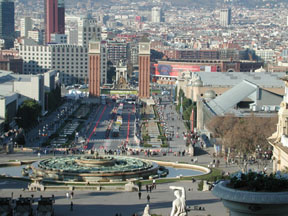The Art Tourist at the Joan Miro Foundation, Barcelona
Women's show challenges curators
by Terry Talty
 Barcelona – A very heady brochure promised us that we would be stunned if we saw the way artistmen have looked at women – as objects – and painted or sculpted them for centuries. The trouble is this stunning view is what we are accustomed to seeing in all the museums of the world, all over television and in print – woman-as-object is the norm. I'm not sure the curators of this show are women, but they assumed that women's issues were obvious to we, the viewers. Their task, which they may not realize is immense, is to get the average Joe to even notice that he views a woman as an object. To show him beautiful objects of art and say, ³See, these guy just viewed these women as objects,² isn't going to shift any thinking. It will reinforce the idea that beautiful objects are beautiful. I'm not sure how successful the organizers have been at accomplishing their immense task.
Barcelona – A very heady brochure promised us that we would be stunned if we saw the way artistmen have looked at women – as objects – and painted or sculpted them for centuries. The trouble is this stunning view is what we are accustomed to seeing in all the museums of the world, all over television and in print – woman-as-object is the norm. I'm not sure the curators of this show are women, but they assumed that women's issues were obvious to we, the viewers. Their task, which they may not realize is immense, is to get the average Joe to even notice that he views a woman as an object. To show him beautiful objects of art and say, ³See, these guy just viewed these women as objects,² isn't going to shift any thinking. It will reinforce the idea that beautiful objects are beautiful. I'm not sure how successful the organizers have been at accomplishing their immense task.
The curators did something very interesting at the beginning of the show. They created a small intimate room of self-portraits by women artists. Later in the show, there would be some photographs of women by men, but while viewing this room we just had to think of any of the major photographers of the 20th Century to see a big contrast between the way women photographed themselves and the way Ansel Adams did. Woman artists who were more obscure than these big names of the last century made most of the photographs in this powerfully emotional collection, and most of the images were from early in the 1900s. The images were each bold self-description, self-assured or at least prominent, and not coyly seductive.
My companion, who is male, thought the photographs were nice but didn't see any difference from photos such as those Steiglitz had made of Georgia O'Keefe. Steiglitz' are the closest examples of photos of self-possessed women. That's a compliment to Steiglitz. In these self-portraits the woman was pushing the buttons and it was evident in the shot setup. They were asking you to look at them as they set it up and this wasn't always with body parts arranged to be sexually stimulating. Imogene Cunningham was one of the most well-known artists included in this roomful of women's work, and we are reminded by looking at her work of familiar images -- her photographs of women of the depression area – that are a pop culture symbol of brave women looking like they look everyday, being themselves in a difficult time.
Since the point of this show was to say that popular culture images don't accurately portray woman, I was well set up by this first room to understand the concept; my companion was skeptical. And – uh,oh – there were just beautiful images of woman throughout the next several galleries of the show. Because it was at the Miro foundation, they used a lot of work by Miro and his friends. Maybe Miro was particularly sexist, but he conveys the female form as a beautiful subject in beautiful objects of art.
Finally, we arrived at more contemporary art where we could see more work by female artists and the work by Niki de Saint Phalle -- specifically giant sculptures of woman made from the products of the typical home. They were ordinary objects, some very beautiful, collaged together in a very large, very messy way, to form the image of a woman vacuuming for example. I get it, an image of an ordinary woman, made of ordinary household stuff.
³I don't like messy sculpture,² said my companion. ³There were so many unnecessary pieces in those sculptures. If you removed any one, or several, it wouldn't have made a difference to the sculpture.²
He's right. So was St. Phalle. Tough job that of curator.